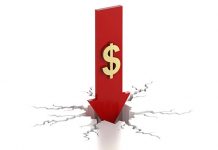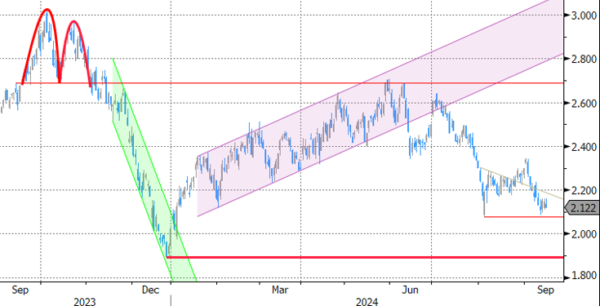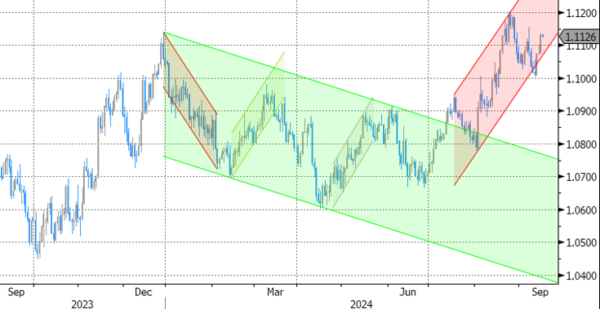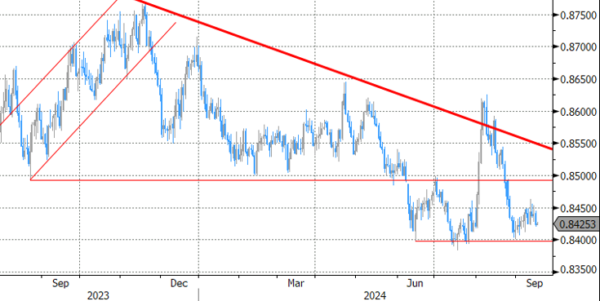Markets
With investors counting down to the Fed policy decision on Wednesday, yields moving further south still was the path of least resistance on US (and EMU) interest rate markets. Maybe a bit strange that when discussing a jumbo rate cut at the start of the easing cycle, the long end of the US yield curve outperformed (2-y -3.1 bps, 30-y -5.1 bps). Technical considerations might have been in play. The 2-y yield is already testing the March 2023 low. Longer maturities are falling below (10-y) or are testing 30-y the December 2023 low. Also something to keep an eye on, the US 10-y real yield remains on a protracted downward trajectory (cycle top 2.58% October last year, 2.30% end April and currently nearing the 1.50% barrier). This suggests already a substantial easing of financial conditions. Economic data were few. The New York Fed manufacturing survey showed an unexpected sharp rebound, both for the current conditions measures (11.5 from -4.7) and for the 6M ahead expectations (30.6 from 22.9). The release triggered some brief jitters on the intraday graphs, but didn’t change the overall trend. In the end markets further raised the odds for a 50 bps step on Wednesday to 70%+. German Bunds still underperform Treasuries as several ECB governors (Kazaks, Kazimir, de Guindos) fully supported a data-dependent approach with many of them signalling reluctance on the room to already make a next step at the October meeting. Bund yields eased between 2.8 bps and 3.1 bps. A further loss of interest rate support (decline in the US real yield) also makes south the path of least resistance for the US dollar. EUR/USD regained the 1.11 barrier (close 1.1133). DXY is only a whisker away from key support at 100.51 (YTD low) and at 100.23 (end December 2023 low). USD/JPY intraday briefly dropped below the 140 barrier, but still closed at 140.62. Equities showed a mixed picture (Dow +0.55%, Nasdaq -0.52%). Oil tries a bottoming out process after the sell-off late August/early September.
Japanese markets this morning reopen in a risk-off mode. However, this time it doesn’t really help the yen. USD/JPY holds little changed at 140.65. DXY shows no clear trend (100.75). US yields tentatively rise about 1.0 bp. Later today, US retail sales, production data and the NAHB housing index are providing final input for tomorrow’s Fed policy decision. Headline August US retail sales are expected to ease marginally (-0.2%) after strong July reading (soft auto & gas sales expected). Control group sales are expected at 0.3%. We don’t expected today’s data to profoundly change markets’ assessment on tomorrow’s Fed interest rate decision. As already indicated yesterday, it’s all about Fed tactics, more than about data. With key technical levels nearby in US yields (cf supra) and in the dollar (DXY 100.25/50 area, EUR/USD 1.1155/1.1202), some order-driven technical trade might be on the cards.
News & Views
Czech National Bank member Holub, who leaves the board by the end of the year, argued in favour of continuing with making monetary policy less restrictive at the final two meetings of the year, bringing the policy rate down to 4% from currently 4.5%. Even a reduction to 3.75% by end 2024 would still mean slightly restrictive monetary conditions. “It would be premature to end or pause the rate-cutting cycle. The economy is bouncing from the bottom but in a very hesitant way.” Both headline and core inflation are close enough to target which in Holub’s view means there no need for such a restrictive policy. Slowed-than-expected wage growth, subdued private spending and weaker demand for Czech exports all cement the inflation outlook. Services inflation is also showing signs of a gradual slowdown while easing cycles by the Fed and the ECB should fend off downward pressure on the Czech koruna. EUR/CZK bounced off the psychologic 25 barrier earlier this month to currently change hands at 25.15. There’s strong technical resistance in the 25.40/50 area.
Former Fed vice-chair and current National Economic Council director Lael Brainard said that with inflation coming back down to normal levels, it is important to safeguard the important labour market progress made. She pointed to sticky housing prices, without which CPI is only rising about 1.8% Y/Y, below the Fed’s 2% price goal. She added that the US actually needs more homes to get to greater affordability. That will be more possible in an environment that is more supportive in terms of the market interest rates.
Graphs
GE 10y yield
The ECB cut policy rates by 25 bps in June and in September. Stubborn inflation (core, services) make follow-up moves less evident. We expect the central bank to stick with the quarterly reduction pace. Disappointing US and unconvincing EMU activity data dragged the long end of the curve down. The move accelerated during the early August market meltdown.
US 10y yield
The Fed in its July meeting paved the way for a first cut in September. It turned attentive to risks to the both sides of its dual mandate as the economy is moving to a better in to balance. The pivot weakened the technical picture in US yields. A string of weak eco data and a risk-off market climate pushed and kept the 10-yr sub 4%. We think we could be up to three 50 bps rate cuts this year.
EUR/USD
EUR/USD moved above the 1.09 resistance area as the dollar lost interest rate support at stealth pace. US recession risks and bets on fast and large rate cuts trumped traditional safe haven flows into USD. EUR/USD 1.1276 (2023 top) serves as next technical references.
EUR/GBP
The BoE delivered a hawkish cut in August. Policy restrictiveness will be further unwound gradually on a pace determined by a broad range of data. The strategy similar to the ECB’s balances out EUR/GBP in a monetary perspective. Recent better UK activity data and a cautious assessment of BoE’s Bailey at Jackson Hole are pushing EUR/GBP lower in the 0.84/0.086 range.


















